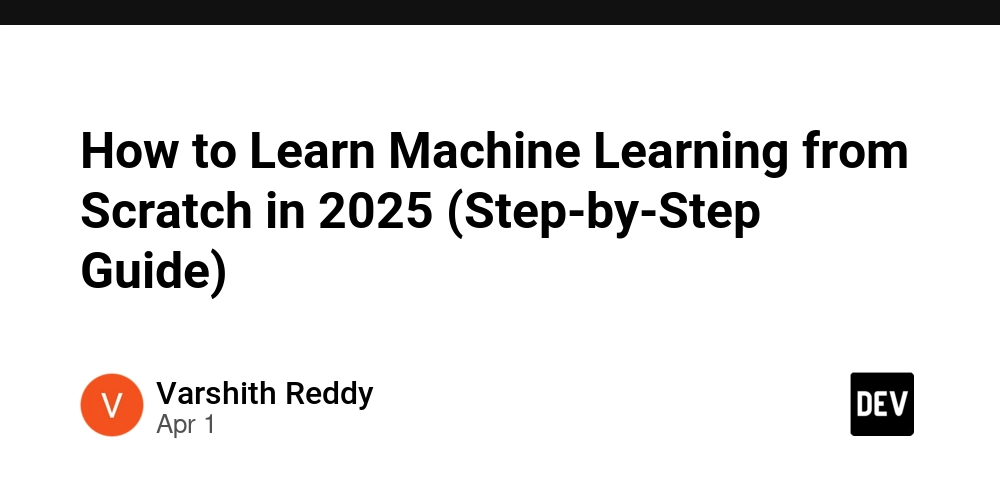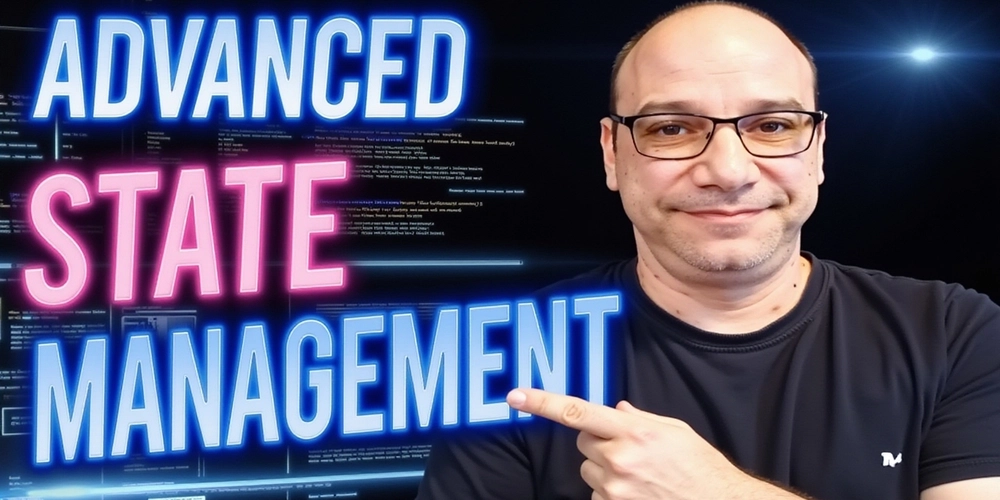How to Learn Machine Learning from Scratch in 2025 (Step-by-Step Guide)
Introduction Machine Learning (ML) has become one of the most in-demand skills of 2025, with AI transforming industries and creating new job opportunities. But if you're new to the field, the journey to becoming an ML expert can seem overwhelming. Where do you start? What should you learn first? In this guide, we'll walk you through a step-by-step roadmap to help you learn Machine Learning from scratch. Whether you're a beginner or looking to sharpen your skills, this guide will take you through everything you need to know, including essential programming languages, algorithms, and real-world projects. What is Machine Learning? (Explained Simply) Machine Learning is a branch of Artificial Intelligence (AI) that allows computers to learn from data without being explicitly programmed. Instead of following hard-coded rules, ML algorithms identify patterns in data and make decisions based on those patterns. For example, ML is used in: Recommendation Systems – Like Netflix recommending your next favorite show. Voice Assistants – Like Siri or Alexa understanding your voice commands. Image Recognition – Like Google Photos identifying objects in your pictures. By learning ML, you'll be able to work with these technologies and create innovative solutions across industries like healthcare, finance, gaming, and more. Why Learn Machine Learning in 2025? Machine Learning isn't just a trending technology—it's shaping the future of work and technology. Here are a few reasons why learning ML is crucial in 2025: High Demand for ML Skills: Companies are looking for ML engineers to help them integrate AI into their operations. Lucrative Career: The average salary for ML engineers is $100,000+ per year. Future-Proof: As AI continues to evolve, ML will only become more relevant in the years to come. Learning ML today opens doors to a wide variety of career paths, from data scientist to AI researcher. Step-by-Step Roadmap to Learn Machine Learning from Scratch Step 1: Learn Python for Machine Learning Python is the most widely-used programming language in Machine Learning, and for good reason. It's easy to learn, has a large community, and offers a vast array of libraries (like NumPy, Pandas, Matplotlib, and Scikit-learn) for ML tasks. Start with basic Python programming: Learn syntax, loops, conditionals, and functions. Practice with small projects: Build basic programs like calculators or to-do lists. Move on to data handling: Learn to work with data structures, libraries like Pandas and NumPy to manipulate and analyze data. visit this For Roadmap Suggested Resources: Python Official Documentation Learn Python for Data Science Step 2: Understand Key Machine Learning Algorithms Once you're comfortable with Python, it's time to dive into the core algorithms that power Machine Learning. Supervised Learning: Algorithms that learn from labeled data, such as Linear Regression and Decision Trees. Unsupervised Learning: Algorithms that identify patterns in data without labels, like K-Means Clustering. Reinforcement Learning: Algorithms that learn by interacting with an environment, like Q-Learning. Practice: Implement basic algorithms on datasets, such as Iris Dataset or Titanic Dataset, and visualize results using libraries like Matplotlib. Step 3: Work on Machine Learning Projects One of the best ways to solidify your knowledge is to apply what you've learned through hands-on projects. Start with beginner-level projects: Predict House Prices: Use Linear Regression to predict the price of houses based on features like size, location, etc. Spam Email Detection: Use a classification algorithm like Logistic Regression to predict whether an email is spam or not. Project Ideas: Image Classification with CNNs: Classify images into categories using Convolutional Neural Networks (CNNs). Sentiment Analysis: Use Natural Language Processing (NLP) to classify the sentiment of text (positive, negative, or neutral). Best Free & Paid Resources for Learning Machine Learning Free Resources Coursera (Andrew Ng’s Machine Learning Course) – A must-do course for beginners. Kaggle – Offers datasets and free ML courses. YouTube Channels – Channels like StatQuest and The Coding Train offer tutorials on ML algorithms and Python. Paid Resources Udemy – Offers in-depth ML courses. Recommended: "Python for Data Science and Machine Learning Bootcamp" DataCamp – Offers a variety of ML courses, from beginner to advanced levels. Conclusion – Start Your ML Journey Today! Machine Learning is a powerful tool that will continue to grow in demand. By learning the fundamentals, mastering Python, and working on real-world projects, you’ll be well on your way to becoming an ML expert. The key to success is consistency. Dedicate time each day to learning and pra

Introduction
Machine Learning (ML) has become one of the most in-demand skills of 2025, with AI transforming industries and creating new job opportunities. But if you're new to the field, the journey to becoming an ML expert can seem overwhelming. Where do you start? What should you learn first?
In this guide, we'll walk you through a step-by-step roadmap to help you learn Machine Learning from scratch. Whether you're a beginner or looking to sharpen your skills, this guide will take you through everything you need to know, including essential programming languages, algorithms, and real-world projects.
What is Machine Learning? (Explained Simply)
Machine Learning is a branch of Artificial Intelligence (AI) that allows computers to learn from data without being explicitly programmed. Instead of following hard-coded rules, ML algorithms identify patterns in data and make decisions based on those patterns.
For example, ML is used in:
- Recommendation Systems – Like Netflix recommending your next favorite show.
- Voice Assistants – Like Siri or Alexa understanding your voice commands.
- Image Recognition – Like Google Photos identifying objects in your pictures.
By learning ML, you'll be able to work with these technologies and create innovative solutions across industries like healthcare, finance, gaming, and more.
Why Learn Machine Learning in 2025?
Machine Learning isn't just a trending technology—it's shaping the future of work and technology. Here are a few reasons why learning ML is crucial in 2025:
High Demand for ML Skills: Companies are looking for ML
engineers to help them integrate AI into their operations.Lucrative Career: The average salary for ML engineers is
$100,000+ per year.Future-Proof: As AI continues to evolve, ML will only become
more relevant in the years to come.Learning ML today opens doors to a wide variety of career
paths, from data scientist to AI researcher.
Step-by-Step Roadmap to Learn Machine Learning from Scratch
Step 1:
Learn Python for Machine Learning
Python is the most widely-used programming language in Machine Learning, and for good reason. It's easy to learn, has a large community, and offers a vast array of libraries (like NumPy, Pandas, Matplotlib, and Scikit-learn) for ML tasks.
- Start with basic Python programming: Learn syntax, loops, conditionals, and functions.
- Practice with small projects: Build basic programs like calculators or to-do lists.
- Move on to data handling: Learn to work with data structures, libraries like Pandas and NumPy to manipulate and analyze data.
visit this For Roadmap
Suggested Resources:
Python Official Documentation
Learn Python for Data Science
Step 2:
Understand Key Machine Learning Algorithms
Once you're comfortable with Python, it's time to dive into the core algorithms that power Machine Learning.
- Supervised Learning: Algorithms that learn from labeled data, such as Linear Regression and Decision Trees.
- Unsupervised Learning: Algorithms that identify patterns in data without labels, like K-Means Clustering.
- Reinforcement Learning: Algorithms that learn by interacting with an environment, like Q-Learning.
Practice:
Implement basic algorithms on datasets, such as Iris Dataset or Titanic Dataset, and visualize results using libraries like Matplotlib.
Step 3:
Work on Machine Learning Projects
One of the best ways to solidify your knowledge is to apply what you've learned through hands-on projects.
Start with beginner-level projects:
- Predict House Prices: Use Linear Regression to predict the price of houses based on features like size, location, etc.
- Spam Email Detection: Use a classification algorithm like Logistic Regression to predict whether an email is spam or not.
Project Ideas:
- Image Classification with CNNs: Classify images into categories using Convolutional Neural Networks (CNNs).
- Sentiment Analysis: Use Natural Language Processing (NLP) to classify the sentiment of text (positive, negative, or neutral).
Best Free & Paid Resources for Learning Machine Learning
Free Resources
Coursera (Andrew Ng’s Machine Learning Course) – A must-do course for beginners.
Kaggle – Offers datasets and free ML courses.
YouTube Channels – Channels like StatQuest and The Coding Train offer tutorials on ML algorithms and Python.
Paid Resources
Udemy – Offers in-depth ML courses. Recommended: "Python for
Data Science and Machine Learning Bootcamp"DataCamp – Offers a variety of ML courses, from beginner to
advanced levels.
Conclusion
– Start Your ML Journey Today!
Machine Learning is a powerful tool that will continue to grow in demand. By learning the fundamentals, mastering Python, and working on real-world projects, you’ll be well on your way to becoming an ML expert.
The key to success is consistency. Dedicate time each day to learning and practicing, and soon you'll see the results.
Are you ready to start your ML journey? Let us know in the comments below, and feel free to ask any questions!











































































































































































![[The AI Show Episode 142]: ChatGPT’s New Image Generator, Studio Ghibli Craze and Backlash, Gemini 2.5, OpenAI Academy, 4o Updates, Vibe Marketing & xAI Acquires X](https://www.marketingaiinstitute.com/hubfs/ep%20142%20cover.png)




























































































































![[DEALS] The Premium Learn to Code Certification Bundle (97% off) & Other Deals Up To 98% Off – Offers End Soon!](https://www.javacodegeeks.com/wp-content/uploads/2012/12/jcg-logo.jpg)


![From drop-out to software architect with Jason Lengstorf [Podcast #167]](https://cdn.hashnode.com/res/hashnode/image/upload/v1743796461357/f3d19cd7-e6f5-4d7c-8bfc-eb974bc8da68.png?#)








































































































.png?#)

































_Christophe_Coat_Alamy.jpg?#)
 (1).webp?#)





































































































![Apple Considers Delaying Smart Home Hub Until 2026 [Gurman]](https://www.iclarified.com/images/news/96946/96946/96946-640.jpg)
![iPhone 17 Pro Won't Feature Two-Toned Back [Gurman]](https://www.iclarified.com/images/news/96944/96944/96944-640.jpg)
![Tariffs Threaten Apple's $999 iPhone Price Point in the U.S. [Gurman]](https://www.iclarified.com/images/news/96943/96943/96943-640.jpg)




































































































































